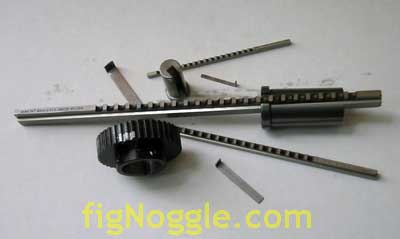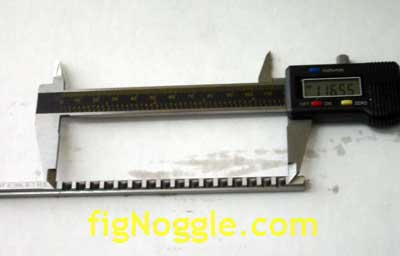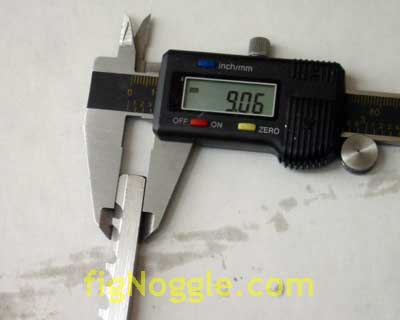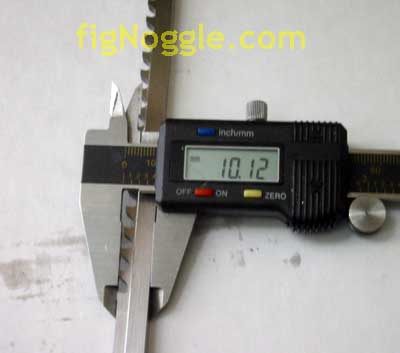
Copyright 2011. figNoggle Designs.
7x10, 7x12, 7x14 Mini-Lathe Information
Website Links
Post a link to your website or view other hobby and machine and metalworking websites for free.
Rent Mill & Lathe DVDs at Smartflix | Great aluminum & steel prices at OnlineMetals
KEYWAY, SQUARE, AND OTHER BROACHING TOOLSEver wondered how to cut a keyway for a gear or a timing pulley? You can get by using you lathe and a square cutting blank that's ground with the right relief and width as described here, or you can buy a dedicated keyway broach. What's a broach? Think of it as a long metal shank with a series of shark's teeth on one side of it. By sliding this shank through the item to broach, it cuts progressively deeper as you slide the shank further through the hole. To keep the shank (broach) centered, a bushing is used. Either a collared or plain bushing can be used depending on your need. The bushing is nothing more than a piece of round bar with a slot cut through the length the width of the broach. Shims are also used to increase the cutting depth per pass. Again, nothing fancy here - just a piece of flat stock of a certain thickness and width with a right angle bend on it to keep it in place as the broach slides through the hole and bushing.
What makes things a bit more interesting is when a keyway needs to be cut in a hole that is of a diameter that's different from the bushing sizes made. How do we overcome this? Simple (if you have a mill or shaper). After turning down the diameter of piece of round bar to the correct diameter as your gear (for example), you simply mill a slot of the proper depth and width down the length of it. In this case, it's best to use a hard, perhaps ferrous metal, like steel (instead of aluminum) since this piece will rub (even with proper oiling as suggested by the manufacturer) against the back of the broach. In the USA, you can readily get broaches from companies like duMont (located in Greenfield, MA, USA) or the Asian imports through the usual suspects of metalworking catalogs. In the case of going metric, however, your most likely candidate will be duMont "Minute Man" broaches. Go figure that there aren't Asian imports of metric sized broaches.. Let's examine a 4mm duMont keyway broach to see how they work: Here's a picture of the cutting teeth - approximately 110mm in length (using very rough estimates)
Starting at the bottom end of the broach (the firsth tooth) we get a depth of 9mm:
At the top end, its depth is 10mm.
There are 16 teeth which translates to each tooth removing just 1/16 mm = 0,0625 mm or 0.0024625" and eventually 1mm (10mm-9mm) per pass of the broach! From this rough calculation, we can say (using very generalized assumptions) that should you opt to use the lathe method that only 1-2 thousandths (0.001"-0.002") of an inch be removed per pass. This also means that adjusting the depth of the keyway slot is determined by the shims that you apply with each pass. In the first picture at the top of the page you see L-shaped metal pieces - these are the shims. With the 4mm (wide) keyway broach, the shim measures at 1mm thick. This makes sense since each pass of the broach yields a 1mm depth of cut. You need not buy these shims at roughly $2-3$ per piece if you have other metal (steel preferred over aluminum, brass, copper, etc..). They are after all, nothing more than a piece of shim stock of 1mm thickness (depending on the broach used). Stay tuned as we post pictures and a pictorial how-to on its usage...
|
Looking for mini-mill help and how-tos? How about lathe help and how-tos?
We're prototyping a benchtop CNC vertical mill using the DigiSpeed-XL interface card for Mach, Dart Controls and KB Electronics KBIC/KBMM 90VDC motor controllers, 1.5HP treadmill motor from Surplus Center and a R8-spindle head from the X2 mini-mill - not to mention Gecko servo drives and an entirely closed-loop system. Come take a look!CNC 8x12 Lathe
Check out our newest developments like the CNC/DRO 8x12/8x14 lathe using Gecko drives, break-out board, NEMA 34 step motors, DRO and more!
SUPERX3.COM
Sieg X3 and Super X3 Grizzly G0463 Info
MDAHacks.com
T-Mobile MDA / Cingular 8125 / HTC Wizard Hacks, Tweaks, Tips, Tricks and More!
Metal Working FAQ.NET
Your source for metalworking and machining, tips, tricks, and more. Over 50 content wiki sites!



